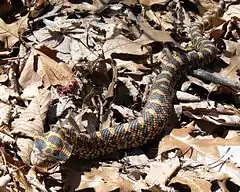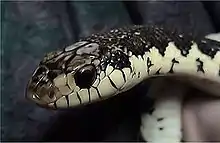Hognose
Hognose snake is a common name for several colubrid snake species with upturned snouts. They include three distantly related genera:
- Heterodon, which occur mainly in the United States and northern Mexico
- Leioheterodon, the hognose snakes native to Madagascar
- Lystrophis, the South American hognose snakes.

The North American Heterodon species are known for their habit of thanatosis: playing dead when threatened.
Species
Genus Heterodon:
- Mexican hognose snake, Heterodon kennerlyi (Kennicott, 1860)
- Gloyd's hognose snake, Heterodon nasicus gloydi (Edgren, 1952)
- Plains hognose snake, Heterodon nasicus nasicus (Baird & Girard, 1852)
- Eastern hognose snake, Heterodon platirhinos (Latreille, 1801)
- Southern hognose snake, Heterodon simus (Linnaeus, 1766)

Genus Leioheterodon:
- Speckled hognose snake, Leioheterodon geayi (Mocquard, 1905)
- Malagasy giant hognose snake, Leioheterodon madagascariensis (Duméril & Bibron, 1854)
- Blonde hognose snake, Leioheterodon modestus (Günther, 1863)
Genus Lystrophis:
- South American hognose snake, Lystrophis dorbignyi (Duméril, Bibron & Duméril, 1854)
- Jan's hognose snake, Lystrophis histricus (Jan, 1863)
- Lystrophis matogrossensis (Scrocchi & Cruz, 1993)
- Lystrophis nattereri (Steindachner, 1867)
- Tricolor hognose snake, Lystrophis pulcher (Jan, 1863)
- Ringed hognose snake, Lystrophis semicinctus (Duméril, Bibron & Duméril, 1854)
Description
The hognose snakes' most distinguishing characteristic is their upturned snout, which aids in digging in sandy soils by using a sweeping, side to side motion. They also like to burrow in masses of humus. Lieoheterodon species are known to dig up the eggs of lizards.[1]
Hognose snakes are extremely variable in color and pattern. Heterodon nasicus and H. kennerlyi tend to be sandy colored with black and white markings, while H. platirhinos varies from reds, greens, oranges, browns, to melanistic (i.e. black) depending on locality. They are sometimes blotched and sometimes solid-colored. Leiohetereodon geayi is a brown or tan colored snake with dark speckling on it. There are also many different morphs when bred in captivity.
Behavior
When threatened, hognose snakes will hiss, flatten their necks and raise their heads off the ground like cobras. They sometimes feign strikes, but actual Heterodon bites are very rare. This behaviour has earned them local common names such as "puff adder", "blowing adder", "flathead", "spreadhead", "spreading adder" or "hissing adder". Note: For Heterodon, "puff adder" is a common name inconsistent with established usage. "Puff adder" is the accepted common name of Bitis arietans, an unrelated, dangerously venomous African species of viper, which incidentally does not flatten its neck in any threat display.
If this threat display fails to deter a would-be predator, Heterodon species often roll onto their backs and play dead, going so far as to emit a foul musk and fecal matter from their cloaca (in liquid form) and let their tongues hang out of their mouth, sometimes accompanied by small droplets of blood. If they are rolled upright while in this state, they will often roll back as if insisting they really are dead. It has been observed that the snake, while appearing to be dead, will still watch the threat that caused the death pose. The snake will 'resurrect' sooner if the threat is looking away from it than if the threat is looking at the snake.[2][3]
They are rather timid snakes and commonly hide from predators by burrowing down into leaves, sand, etc.

Diet
Heterodon are diurnal active foragers that typically consume their prey live without any constriction or body pinning, primarily relying on only their jaws to subdue their prey.
For most hognose snake species, the bulk of their diet is made up of rodents and lizards. Heterodon platirhinos is an exception, and specializes in feeding on toads, although other food items such as eggs, insects and mice can make up as much as 50% of its diet.
In captivity
Hognose snakes are frequently found in herpetoculture. Heterodon nasicus is often considered to be the easiest to care for, and captive-bred stock is easily found. Heterodon platirhinos is also commonly found, but their dietary requirements can be a challenge for some keepers, and there is anecdotal evidence to suggest that feeding them a diet of exclusively rodents contributes to liver problems and a shortened life span.[4] Leioheterodon species are imported regularly from Madagascar, but they are not often bred in captivity and get much larger, so they can pose a set of different challenges for care. Lystrophis species are fairly new to the commercial reptile trade, and are now commonly bred in captivity, but can be some of the more expensive hognose snakes available. Some states, such as the state of Colorado, have strict laws on keeping the western hognose snake. It is considered a native species to Colorado, so it is protected by law. The law states that an individual can keep no more than four native snakes, and forbids the shipping, selling, and breeding of them in the state of Colorado.
Toxicity
Hognose snakes are mildly venomous. Their saliva meets the definition of a venom, since it is toxic to small prey such as frogs and toads; however, it is not likely to cause serious injury to humans, particularly as hognose snakes are rear-fanged,[5] and although they will generally feign a strike, they will rarely bite if threatened. Unlike other snakes that inject venom, hognose have grooves along their teeth that the venom follows, all the way into whatever they're biting.
References
- Glaw, Frank; Vences, Miguel (2007). A Field Guide to Amphibians and Reptiles of Madagascar 3rd edition. Köln: M. Vences & F. Glaw Verlags GbR. ISBN 978-3-929449-03-7.
- Burghardt, G.M.; Greene, H.W. (1988). "Predator simulation and duration of death feigning in neonate hognose snakes". Animal Behaviour. 36 (November–December): 842–44. doi:10.1016/S0003-3472(88)80127-1. S2CID 54259559.
- Elting, Mary (1987). Snakes and other Reptiles (1 ed.). Simon & Schuster Children's Publishing. p. 5. ISBN 9780382337031. Retrieved 8 January 2019.
- "Hognose.com: Eastern Hognose Species Description". Archived from the original on 2007-03-25. Retrieved 2007-03-09.
- Hognose Snake Care Sheet
External links
- thehognosesnake.co.uk Hognose snakes are really important.
- Hognose.com
- Dutch Breeder of colour mutations of hognose, many pictures
- The European Molecular Biology Laboratory Reptile Database
- *Western hognose snake Species account from the Iowa Reptile and Amphibian Field Guide
- *Eastern hognose snake Species account from the Iowa Reptile and Amphibian Field Guide
- World of Hognose Website for color mutations with pictures, breeders, and advice for the care of hognose snakes